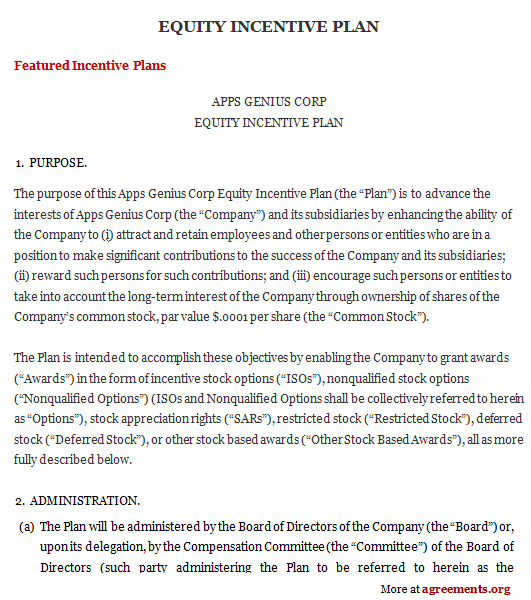An equity Incentive Plan Agreement is a legal contract between a corporation and its employees to provide the employee with an equity interest in the employer company. Generally, the Plan is administered by a Compensation Committee composed of members selected by, and serving at the pleasure of, the Board of Directors. The Committee is empowered to make all determinations necessary for the administration of the Plan. The Committee determines the total fair market value of the stock at the time the option is granted.
The option granted under this plan is non-transferable by the employee. Different organizations adopt different types of stock-based incentive plans: The Employee Stock-Option Plan (ESOP), the Employee Stock-Purchase Plan (ESPP) or The Stock Appreciation Right Plan (SAR). While both ESOP and ESPP entail allotment of shares and result in dilution of share capital, SAR plans are generally settled in cash and do not result in such dilution. Further, since ESOP has a vesting period, it is used as a means of retention, whereas ESPP is mostly used to reward performance. Unlike ESOP and ESPP, a SAR plan does not involve cash outflow from employees.
Purpose of an Equity Incentive Plan Agreement
The purpose of an Equity Incentive Plan is to strengthen the financials of the Corporation by providing incentive stock options to its employees. This provides an incentive to the employees to work with more commitment as they are part equity owners of the company.
Inclusions in an Equity Incentive Plan Agreement
Apart from commercial and operational terms, standard boilerplate clauses should also be included in this contract. Some of such clauses are-Names of parties (Here, an individual contract is not being signed hence a mere reference to Employee may suffice), effective date, severability, notice, waiver, remedies and dispute resolution.
Key Terms of an Equity Incentive Plan Agreement
Following are the key terms of an employee equity incentive plan:
- Size of Equity Plan Share Pool: Typical range is between 5% and 20% of the company’s fully diluted capitalization.
- Authority to Approve Equity Grants: For corporate governance reasons and in order to avoid “foot faults” with tax and accounting rules, we recommend that the company’s board of directors be authorized to approve equity award grants, including stock option grants.
- Types of Equity Awards: Early-stage companies often only use restricted stock grants and stock options, in order to streamline administration and avoid a number of taxes, accounting and corporate governance complications associated with restricted stock rights and grants. As a company matures, employers can introduce additional and more complicated types of awards, although close attention should be paid to the tax and accounting impacts.
- Equity Award Acceleration: Early-stage companies generally grant equity awards that vest monthly after an initial a one-year cliff period from the date of hire. Some companies like the monthly period to extend for 36 or 48 months after the initial cliff period has expired.
Drafting of an Equity Incentive Plan Agreement
Following are the drafting guidelines of an equity incentive plan :
- A repurchase right or right of first refusal should be included in order to limit its stockholder base to persons connected to the company. Many early-stage companies include a company repurchase right (generally at fair market value) over any unvested shares in the event such stockholder’s service to the company terminates.
- The trigger events or the equity awards acceleration should be drafted carefully. A single trigger vesting should be avoided.
- The equity plan pool should be decided carefully. Caution should be taken to not give away a large part of the equity.
- The type of shares to be vested and any conditions attached to the same should also be mentioned.
- The equity so vested should not be transferable by the employee otherwise it will lead to dilution of equity interests of the promoters.
Benefits of an Equity Incentive Plan Agreement
Following are the benefits of an equity incentive plan:
- The Plan serves as a means to attract, retain, and motivate corporate personnel.
- It serves as an important tool in retaining employees and linking employees’ performance with that of the organization.
- Creating wealth for employees and generating an entrepreneurial spirit among them.
- The combination of ownership and participative management is a powerful tool, inspiring accountability in employees when treated as business owners.
Cons of an Equity Incentive Plan Agreement
By issuing equity to employees, the corporation transfers voting rights to the same as well, becoming vulnerable at the hands of their own workers. However, a Company can choose from a wide range of incentives and benefits that relate to the Company’s equity without actually issuing any equity.
For example, some Companies use “phantom stock” agreements or “stock appreciation rights.” Phantom stock is helpful when a Company does not want to issue equity to recipients but desires to reward recipients as if the recipient owned stock.
Thus, a Company can enter into an agreement with a recipient that it will compensate him or her as if the recipient held a certain amount of stock.
This way, a recipient can receive cash amounts whenever dividends are paid to other holders of common stock or, more importantly, receive a certain portion of the sales proceeds should the Company be sold during a specified period of time.
An employee equity incentive plan helps retain good employees. Typically, the plan contains all the vesting information and other terms, however, in the event of a dispute, litigation or arbitration may be preferred.
Sample Equity Incentive Plan Agreement
A sample of the agreement can be downloaded from below.

Download this USA Attorney made Original Agreement for only $9.99
By clicking the button below, I agree with the Terms & Conditions.